Scientific Errors in Those Nat Geo Milky Way Photos
![]()
The night sky offers an unlimited source of markers (e.g. stars, constellations, Milky Way, etc.) that never lie about the time of year and location in the world you shot a night sky picture from. You don’t even need to be a professional astronomer or to double-check RAW files to prove it.
National Geographic is at the center of a manipulated photo controversy this week over an article featuring photos by photographer Beth Moon. Moon gave this statement in response:
I am late to this discussion as I am attending my father’s funeral. First, I want to say that I am not much for technical expertise. For me, it’s not about the equipment. For these pictures I developed a fairly simple formula and memorized it, varying adjustments occasionally to suit the light. I also usually take my time producing work, but this work under starlight was the exception. With three back to back trips and a book deadline I enlisted the help of an intern seven years ago. During her 6 month term she helped to batch process images and she also hand-stitched the panoramic shot in question. I got back in touch with her to ask her about this process. She remembers stitching the images together one by one, lining up the tree branches by using the transformation tool to line each shot up. I believe the problem stemmed from the distortion of the wide angle lens used. She claims she did not use the clone tool. To be clear, I am not passing the blame on to her. My name is on it and I take full responsibility.
This is a painful lesson. I am sorry to have upset so many people. I did not intentionally try to hide anything and I apologize. With the passing of my father I am reminded to try to concentrate on a bigger picture, which I hope to do going forward.
In the wake of the controversy raging on the Internet over the past few days, I wanted to take a deeper look at some of the pictures that were published. The goal here was to try and determine if Moon’s pictures were manipulated based on the undeniable science of astronomy.
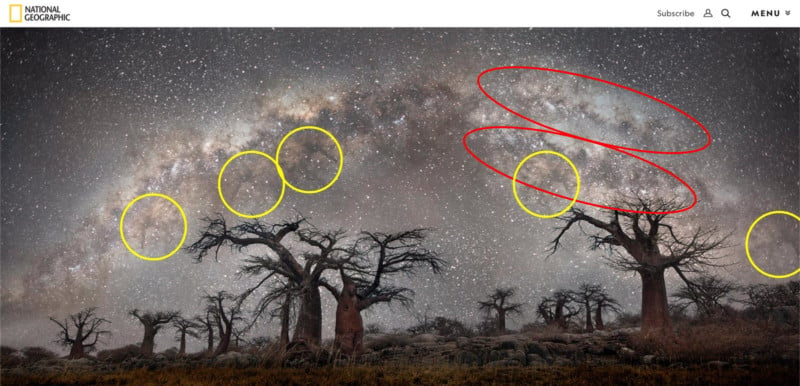
This picture (which was at the center of the controversy) can only be a panorama and not a single exposure. To be able to capture the whole span of the southern hemisphere Milky Way setting, you would need a fisheye lens that would distort the foreground. In this image, a specific warping mode was used during the stitching process, creating a bent Milky Way instead. However, what is most noticeable about the picture is the Milky Way itself. While its position and curvature are definitely possible at the location it was taken (Botswana), its overall shape and look is irrefutably unnatural. Some parts of the Milky Way were quite obviously cloned several times, perhaps to make it look more impressive.
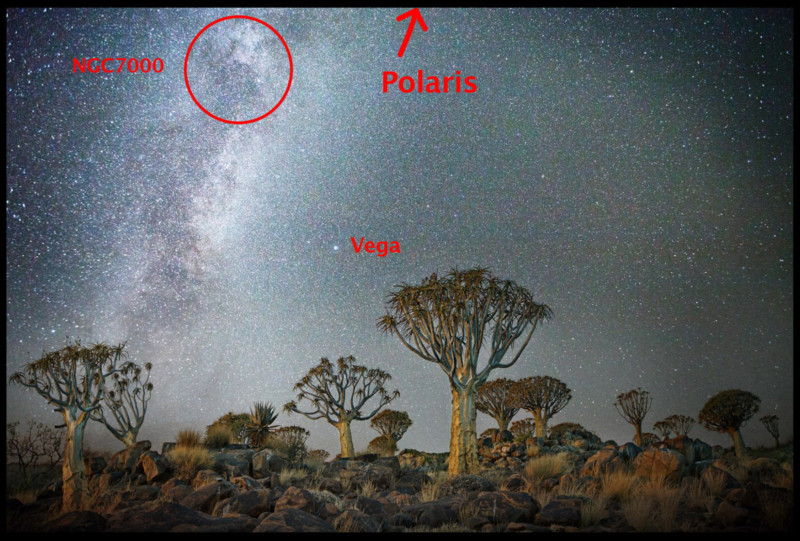
The caption says that this picture was taken in the famous Quiver tree forest in Namibia. However sharp eyes or people that have been to that place will realize that the sky does not match the foreground. For starters, in real life, there is visible light pollution in several directions around the forest and none of this is visible here on the horizon.
However, the most compelling evidence is to have our own galaxy oriented this way. It is simply impossible in the southern hemisphere! You can perhaps recognize NGC 7000 (North American, Pelican nebulae, Sadr region), the bright star Vega and Polaris, which would be located above the frame. But the North Star Polaris can never appear above the horizon below the equator as a rule.
The Cygnus part of the Milky Way, if visible, usually points downwards. All these elements constitute a solid case about the photograph being, in fact, a composite where the foreground was taken in Namibia and the background sky somewhere else in the northern hemisphere, and at a different time of the year.
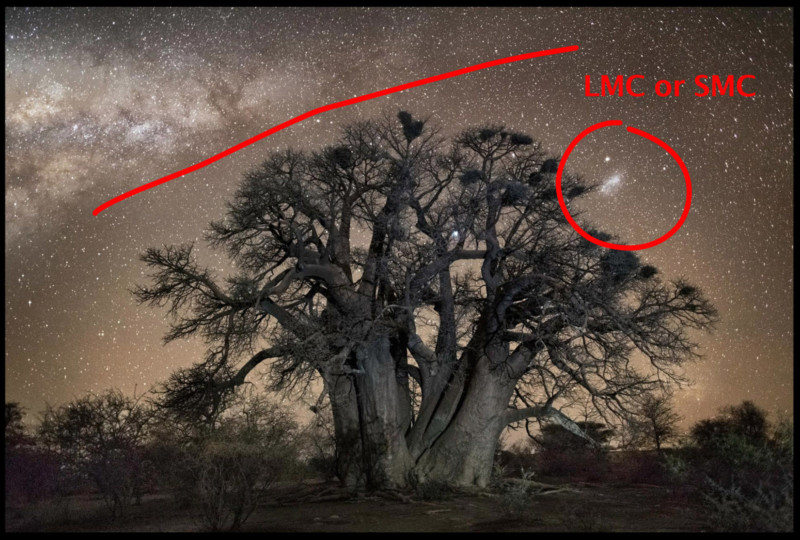
In this picture, the Milky Way appears over a baobab tree of Botswana. The Milky Way appears to be completely cloned out around the Eagle and Shield constellations, which can never happen in real life. In the upper right-hand corner, we can also discern either the Large Magellanic Cloud or the Small Magellanic Cloud completely out of place. This underlines a heavy cloning manipulation in the picture.
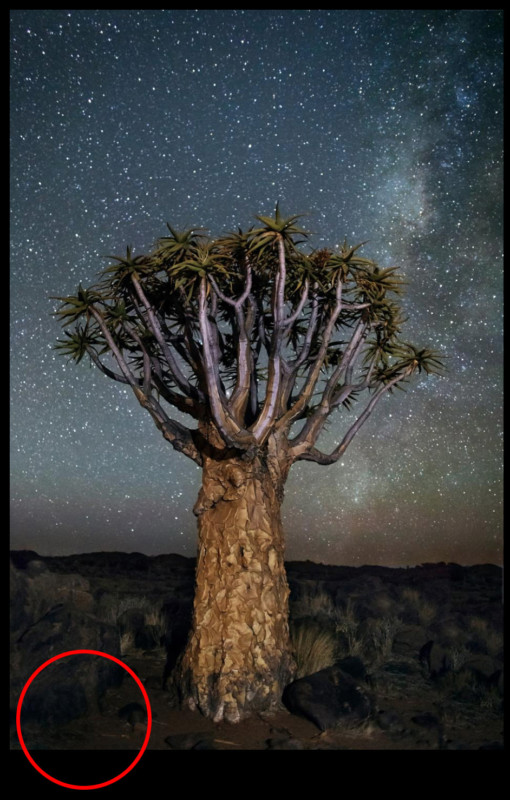
In this picture seemingly taken in Namibia again (with a Quiver tree in the foreground), we can see an upright Milky Way across the top right-hand side. Again the Milky Way can simply never appear in this manner in the southern hemisphere. With this orientation and focal length, the “Southern Star” (the point of the night sky around which the southern hemisphere sky rotates for a viewer from Earth) would be located approximately within the red circle. However this point is right above the horizon in Botswana! So the sky has conveniently been lowered so that the core of the Milky Way appears in the frame.
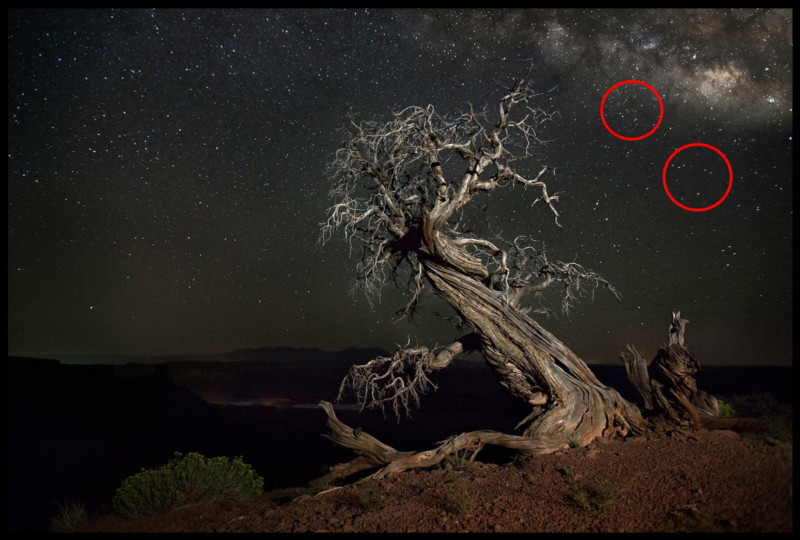
In this picture, shot in Utah, the Milky Way has blatantly been added in. The difference of luminosity of the Milky Way and the overall background sky doesn’t add up. When we zoom in and look at the stars in the Milky Way and outside of it, we can see that they don’t ‘suffer’ from the same aberrations (lens errors that affect the image). The Milky Way stars appear sharper and rounder while the ones below appear blurry and trailing. This only happens the other way around where corners get affected more than the center.
Another disturbing evidence is that the Milky Way has its core too high in the sky for the latitude of Utah. Judging by the size of the Milky Way, I would say the shot has been taken using a 14mm to 20mm lens. If you are stargazing in Utah, there is no way you can get that much distance between the horizon and the core of the Milky Way regardless of the time of year.
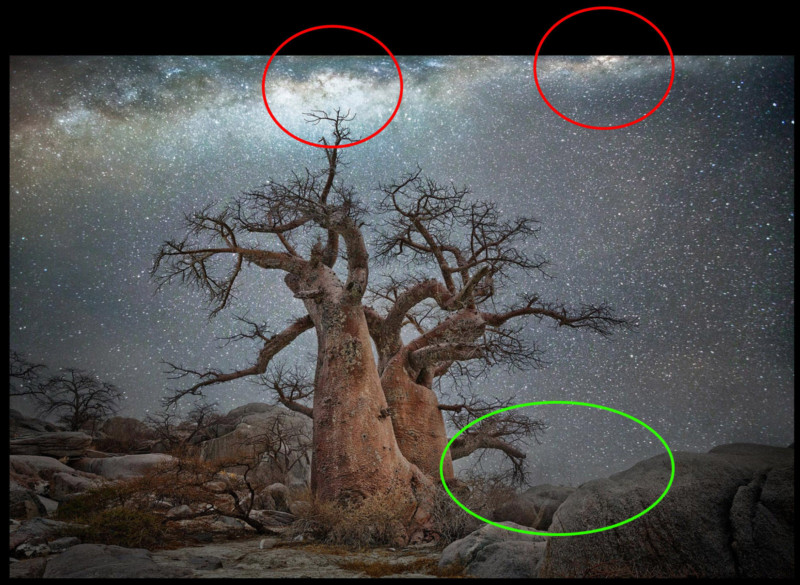
In this final picture, the Milky Way has been cloned and perhaps added in. It’s quite hard to tell what its real position is because you don’t know which part of the Milky Way is legitimate. In the top left-hand corner, we can quite obviously discern the Norma region of the Milky Way. In the top center, there is the core, but it’s the other way around! That bright area circled in red should have been well out of bounds on the other side of the dust lane rift.
As if this wasn’t enough, another clone of the fake core was added in the top right-hand corner. What can also be striking to anyone familiar with astronomy or astrophotography is that there is no atmospheric effect as you get closer to the horizon (you usually see a darker and more colorful layer on the horizon). It’s a natural effect that is always present no matter where on the planet you take a picture from. It’s another piece of evidence suggesting that once again the sky has been quite heavily messed with.
While the problem should not firstly be about these artistic pictures themselves or the photographer who produced them, it should be about how they ended up published by a reputable organization that promotes science and true-to-life ethics. These pictures should never have made it through the publishing process if they had been correctly spotted. However, this raises other questions like why did photographer Moon (or her assistant) have to manipulate the pictures in the first place? A hint could be hidden within the lines of the article:
“Lots of places have either old trees or dark skies, but not both. When the two do intersect, the location is often challenging to reach,” Moon says.
Update on 5/13/19: National Geographic has pulled the article (for now) and released the following statement from its editor:
On April 26, National Geographic published photos by Beth Moon on nationalgeographic.com, depicting the world’s oldest trees against the night sky. Significant concerns about the veracity of the images have been raised on photo industry blogs and social media. National Geographic has a strict policy against photo manipulation, and we have initiated an investigation to confirm whether the images comply with our policies. We have removed the images and related story pending the outcome of our investigation. This step does not mean we have determined that the images do not meet our standards, as we are unable to make a determination at this time. The images will not be re-posted unless they meet National Geographic’s standards.
About the author: Adrien Mauduit is a professional astrophotographer and cinematographer and the CEO and owner of Night Lights Films. The opinions expressed in this article are solely those of the author. Mauduit also does science education, communication, and public outreach for Project PoSSUM. You can find more of Mauduit’s work Facebook, Twitter, and YouTube.